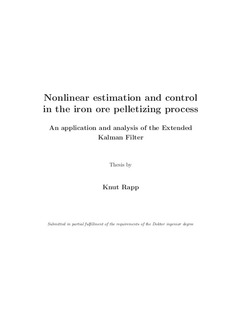| dc.contributor.author | Rapp, Knut | nb_NO |
| dc.date.accessioned | 2014-12-19T14:00:58Z | |
| dc.date.available | 2014-12-19T14:00:58Z | |
| dc.date.created | 2008-05-09 | nb_NO |
| dc.date.issued | 2004 | nb_NO |
| dc.identifier | 124359 | nb_NO |
| dc.identifier.isbn | 82-471-6404-3 | nb_NO |
| dc.identifier.uri | http://hdl.handle.net/11250/259438 | |
| dc.description.abstract | This thesis deals with estimation and control of the balling drums used in the iron ore pelletizing process.
First a conceptually new control scheme for balling drums is proposed. In this control scheme a cluster of drums is considered rather than considering each drum to be an independent unit, and the output of each drum is assumed to be oscillating during normal operation. Three states are essential in this scheme, and these are the amplitude of the oscillation, frequency of the oscillation, and its phase angle. These three states are estimated by use of an extended Kalman filter (EKF). The new control scheme thus depends heavily on the state estimation. A simulation of this scheme controlling a cluster of three drums is carried out. In this simulation the drums are modelled as van der Pol oscillators with varying amplitude and frequency of the output.
Next the problem of automatically tuning and optimizing the extended Kalman filter is addressed. In spite of its importance, there has been published surprisingly few results on this subject, however, two different methods for EKF tuning has been proposed recently in the literature. One of these is tuning by use of a genetic algorithm (GA), which is also applied in this thesis. It is shown that by use of a simple GA, the extended Kalman filter is well tuned in a reasonable amount of time, provided that the tuning criterion is well defined. Furthermore, the same simple GA is applied for optimizing the EKF with respect to its performance in high noise environment.
Finally the stability properties of the EKF is analyzed. It is not possible to guarantee that the states in the signal model used for the state estimation in the new control scheme will be bounded from above, as required in the stability results presented so far. By applying a different bound on the Kalman gain matrix, it is shown that this requirement can be relaxed, and thus convergence of the state estimator applied in the new control scheme can be guaranteed under some given conditions. | nb_NO |
| dc.language | eng | nb_NO |
| dc.publisher | Fakultet for informasjonsteknologi, matematikk og elektroteknikk | nb_NO |
| dc.relation.ispartofseries | Doktoravhandlinger ved NTNU, 1503-8181; 2004:94 | nb_NO |
| dc.relation.haspart | Rapp, Knut; Nyman, Per-Ole. Control of the Amplitude in a Surging Balling Drum Circuit, a New Approach to an Old Problem. Modelling, identification and control. 24(4): 193-203, 2003. | nb_NO |
| dc.relation.haspart | Rapp, Knut; Nyman, Per-Ole. Genetic algorithm based tuning of an Extended Kalman Filter. Proceedings of the 9th IEEE International Conference on Methods and Models in Automation and Robotics, 2003. | nb_NO |
| dc.relation.haspart | Rapp, Knut; Nyman, Per-Ole. Optimization of extended Kalman filter for improved thresholding performance. Proceedings of the 2nd IFAC conference on Control System Design, 2003. | nb_NO |
| dc.relation.haspart | Rapp, Knut; Nyman, Per-Ole. On stability of the Extended Kalman Filter. Proceedings of the 10th IEEE International Conference on Methods and Models in Automation and Robotics, 2004. | nb_NO |
| dc.relation.haspart | Rapp, Knut; Nyman, Per-Ole. Stability properties of the Extended Kalman Filter. Proceedings of the 6th IFAC-Symposium on Nonlinear Control Systems, 2003. | nb_NO |
| dc.title | Nonlinear estimation and control in the iron ore pelletizing process: An application and analysis of the Extended Kalman Filter | nb_NO |
| dc.type | Doctoral thesis | nb_NO |
| dc.contributor.department | Norges teknisk-naturvitenskapelige universitet, Fakultet for informasjonsteknologi, matematikk og elektroteknikk, Institutt for teknisk kybernetikk | nb_NO |
